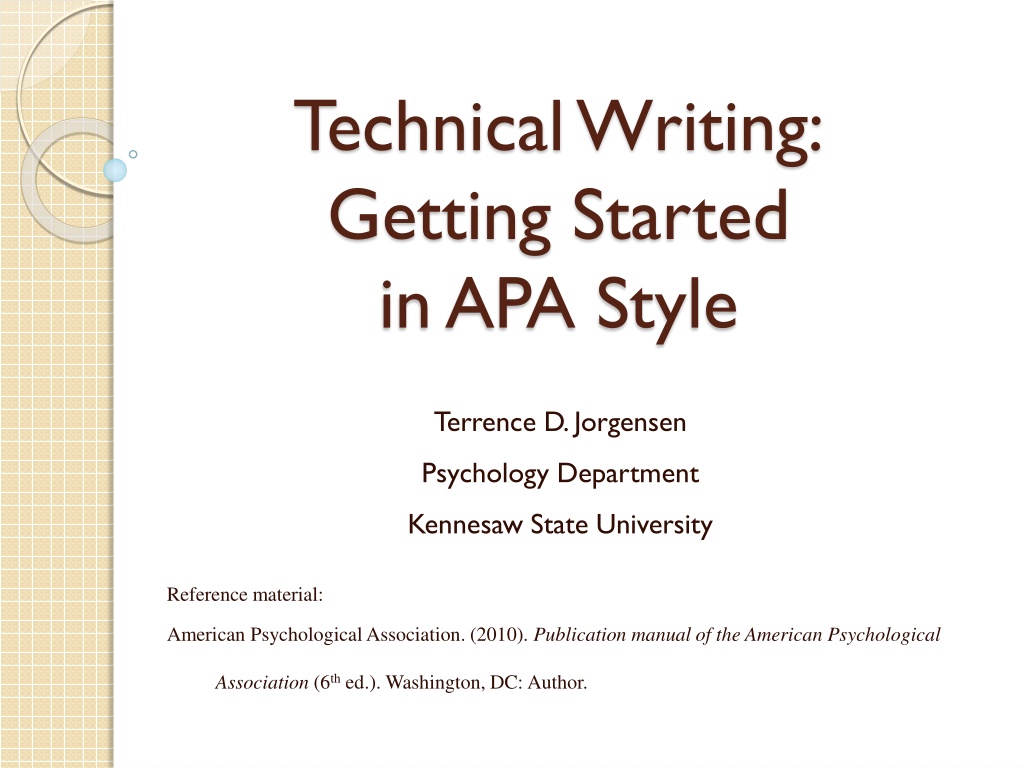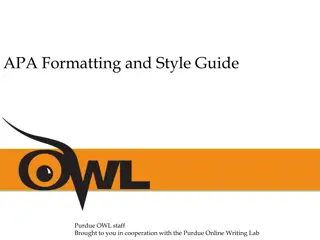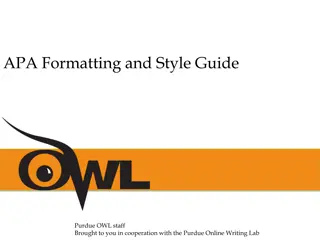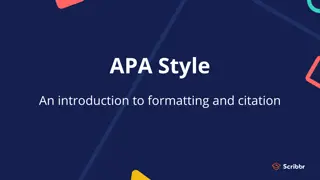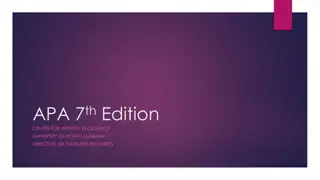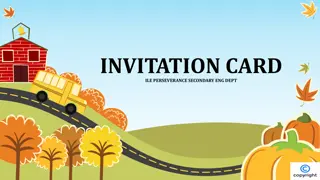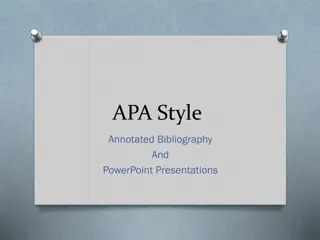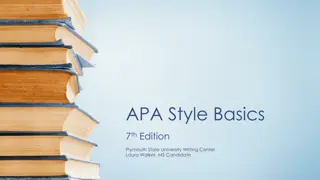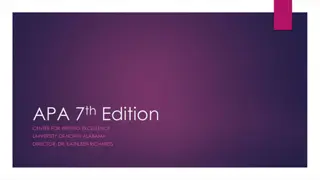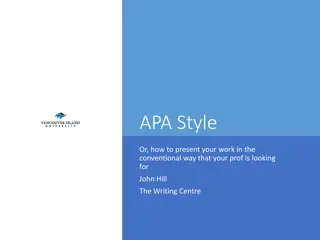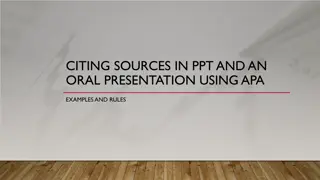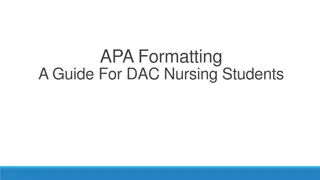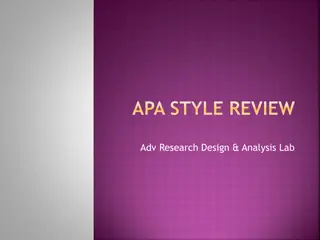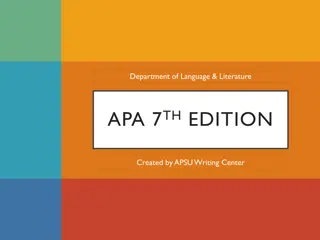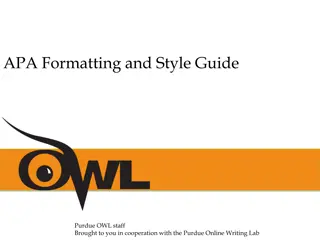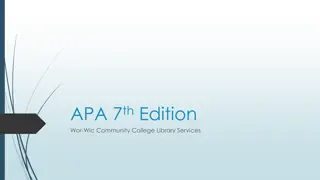APA Style Guidelines for Formal Papers
Implementing APA style guidelines is essential for writing formal papers effectively. This comprehensive guide covers formatting instructions such as margins, font styles, and spacing. It also details the components of a title page, including the title, author's name, and page number formatting. Understanding these rules can help scholars and students in various fields present their work professionally and consistently.
Download Presentation

Please find below an Image/Link to download the presentation.
The content on the website is provided AS IS for your information and personal use only. It may not be sold, licensed, or shared on other websites without obtaining consent from the author.If you encounter any issues during the download, it is possible that the publisher has removed the file from their server.
You are allowed to download the files provided on this website for personal or commercial use, subject to the condition that they are used lawfully. All files are the property of their respective owners.
The content on the website is provided AS IS for your information and personal use only. It may not be sold, licensed, or shared on other websites without obtaining consent from the author.
E N D
Presentation Transcript
Technical Writing: Getting Started in APA Style Terrence D. Jorgensen Psychology Department Kennesaw State University Reference material: American Psychological Association. (2010). Publication manual of the American Psychological Association (6thed.). Washington, DC: Author.
Format Paper Before Beginning One-inch margins on all sides of all pages (set in Page Setup) Use Times New Roman12-pt font (APA pp. 228 229) throughout the entire manuscript, including the header (except for Figures) Double-space throughout entire paper (all sections of Text) Periods ONLY at end of sentences should be followed by 2 spaces (p. 88); use only 1 space between initials and between elements of a Reference entry or headings (they aren t sentences) Indent paragraphs using the tab key, which should be set to inch (set indentation in Paragraph, where you set double spacing) Only exceptions are: Abstract (no indentation; see APA p. 27, p. 229) Reference entries (hanging indentation; see APA p. 37)
Title Page Components Running head & Page # Title Author s name and affiliation Refer to APA pp. 23 24 & see example on p. 41 ONLY the title page has the words Running head preceding the actual abbreviated title
Title Page: Title Refer to APA pp. 23 24 The title should present the main idea of the paper in 10 12 words Recommended no more than 12 words Title should be centered in the upper half of the page Capitalize major words (see p. 101) This includes all words that have 4 or more letters, all (pro)nouns, verbs, adjectives, and adverbs
Title Page: Page Number In Word 2003, go to View Header/Footer Type Running head followed by a colon and key words of title in ALL CAPS Type 5 spaces Click the Page # icon In Word 2007, click the Insert tab, click Page Numbers, and select the page # in the right- hand corner Page header and number should be in the same typeface as the rest of the paper
Title Page: Running head An abbreviated version of the title that makes sense Type the abbreviated title in all uppercase letters, flush left On the title page ONLY, precede the actual running head with the words Running head and a colon In Page Setup under the Layout tab, check the box that says Different first page for the header Must not exceed 50 characters, including punctuation and spaces (refer to APA p. 229) Insert automatic page numbering, press TAB to flush right
Title Page: Author(s) and Affiliation Refer to APA pp. 23 24 Type your name(s) on the first line below the title Center your institutional affiliation (Kennesaw State University) on the next line
Abstract Format Refer to APA pp. 25 27 Notice that the words Running head: are absent from this page forward (you must insert another header/pg #) Center the word Abstract on the top line of the page Capitalize only the A in Abstract Begin the abstract on the next line, without indenting Limit word count according to journal s requirements (usually between 150 250 words; see APA p. 27 & 241) Highlight text and do a word count
Abstract Content The abstract is a summary of the paper See APA p. 26 27 for what to include in Abstracts for different types of papers Begin with the most important information Include the results of your study/review Unless at the beginning of a sentence, you may use digits for ALL numbers (APA p. 111 b)
The Body (Text) of the Paper Center the title on the first line of the page Begin your introduction on the following line Do NOT include the word Introduction Indent all paragraphs (APA p. 229) Check your page number at the top right is 3 Use Boldface font for headings within the Text (p. 62), but labels (e.g., Abstract, References) are not headings
Citations in Text Refer to APA pp. 169 179 Whenever you use another author s work, ideas, or words, you must give them credit with a proper citation. Remember that citations do not excuse plagiarism (see APA pp. 15 16) Authors do not present the work of another as if it were their own work (APA p. 16).
Citations in Text: Basic Form The first time a work is cited in a paragraph, cite the author s (or authors ) last name(s) and the year of publication (see APA p. 174) Walker (2000) studied reaction times A recent study of reaction times (Walker, 2000)... A parenthetical citation (Walker, 2000) must include the year each time A nonparenthetical citation must include the year only the first time per paragraph, unless it could be confused with another citation (APA pp. 174 175, table on p. 177) There may be multiple sources by the same author(s); see APA p. 178 about identical citations
Citations in Text: Basic Form contd When authors names are part of the sentence (try saying your sentence aloud), put only the year in parentheses When the names are not part of the sentence, cite entirely in parentheses: the name(s), comma, then the year When citing multiple authors in parentheses, use an ampersand (&) before the last author The latest results (Enghart & Jones, 2005) show that When citing multiple authors in the text, use the word and Enghart and Jones (2005) found
Citations in Text: Less than 6 Authors Refer to APA p. 175 When a source has only 2 authors, use both authors names in every citation When a source has 3, 4, or 5 authors, cite each last name ONLY in the first citation of the entire paper (excluding Abstract) In subsequent citations, use the first author s name, but shorten the remaining authors to et al. In Roberts, Baldwin, and Yi s (1972) classic study, Same paragraph: Roberts et al. s results indicated a correlation between age and intelligence. New paragraph: Roberts et al. (1972) found that
Citations in Text: 6 or more Authors When a source has 6 or more authors, shorten each citation (including first one in paper) with the first author s last name and all remaining names shortened to et al. In the Reference page, list all names for up to 7 authors For more than 7 authors, list the first 6 names, insert ellipses (3 periods), then list the final author s name Refer to APA p. 184 See example # 2 on APA p. 198
Citations in Text: Direct Quotations Refer to APA pp. 170 174 Citation of page numbers is only required when you are using a direct quote (APA p. 170) The results indicated a strongcorrelation (Lopez, 2004, p. 476) in the negative direction. Page numbers are still strongly encouraged for citations that are paraphrases (APA p. 171) to help your readers find the info For quotations of 40 or more words, use block quotations (see APA p. 171 & example on p. 92) Block paragraph, extra indentation, no quotation marks Citation and page number at end of block If no page number is available (e.g., a webpage or HTML version of journal article), use the section heading and either paragraph symbol or the abbreviation para. Click Insert Symbol, click the Special Characters tab, and find the symbol See examples on APA p. 172
Citation of Secondary Sources Refer to APA p. 178 When you wish to use information that the author of a paper has cited, it is best to obtain the original (primary) source. If this is impossible, cite by listing the author(s) and date of the primary source, followed by the author(s) and date of the secondary source (i.e., the one you read). This confirmed the results (Chen, 1990, as cited in Izerman, 2001). Chen (1990, as cited in Izerman, 2001) found that Refer to APA pp. 175 179 for information on how to cite groups/institutions as authors, works with no author, personal communications, and many other exceptions and special circumstances
Reference Page Format Center the word References at the top of the page Begin your first entry on the next line, including a hanging indentation for subsequent lines Set Indentation to Hanging where you set Spacing to Double References should appear in alphabetical order by the first author s last name (see details on APA pp. 181 182)
Reference Page Content Author(s) Names (see APA p. 184) Begin by listing up to 7 authors last names and initials in the order they appear on the article Saywitz, K. J., Mannarino, A. P., Berliner, L., & Cohen, J. A. Alphabetize nothing before something Saywitz, K. J. goes before Saywitz, K. J., et al. If there are more than 7 authors, list the first 6 names, periods of ellipses ( ), and the final author Saywitz, K. J., Mannarino, A. P., Berliner, L., Cohen, J. A., Smith, K., Dietrich, L., Jordan, K. F. Include space between each initial (or hyphen if name is hyphenated; see APA p. 184) See APA pp. 181 182 about alphabetizing surname prefixes (Mc/Mac, O , de, von/van, ben, ibn)
Reference Page Content: Journal Articles Date & Title Follow the last author name with the year of publication, in parentheses, followed by a period Robertson, L. A. (2004). If the periodical is published monthly or more often, it requires the month and sometimes the full date, accordingly (see APA p. 185) Type(n.d.) to indicate that there is no date available Next, type the article title, capitalizing only the first word of the title and subtitle and any proper nouns Place a period at the end of the title (APA p. 186) Do not italicize the title or use quotation marks Robertson, L. A. (2004). Treatment for clinically depressed adults: A new approach.
Reference Page Content: Journal Articles Publication Information After the article title, enter the journal name and volume number in italics, both followed by commas. Conclude with page numbers of the article (not italicized) and a period. Use an En dash between pages (see APA p. 97). In Word, hold Ctrl and type the minus sign on the number keypad. Robertson, L. A. (2004). Treatment for clinically depressed adults: A new approach. Psychological Bulletin, 122, 125 143. If the journal requires an issue number (see APA p. 186, examples on pp. 199 200), place it immediately after the volume number in parentheses, not in italics. Klimoski, R., & Palmer, S. (1993). The ADA and the hiring process in organizations. Consulting Psychology Journal: Practice and Research, 45(2), 10-36.
Reference Page Content: Books Title and Publication Information Enter the authors names and date of publishing, same as for journal articles. Follow the publication year with the book title in italics (with unitalicized edition in parentheses if applicable), ending with a period (see APA p. 185) Same capitalization rules as article title, not journal title Rules are consistent according to periodical status Follow the title with the location of publication and the publisher, closing with a period (APA pp. 186 187) Beck, C. A. J., & Sales, B. D. (2001). Family mediation: Facts, myths, and future prospects (2nd ed.). Washington, DC: American Psychological Association.
Reference Page: Other Types of Sources There are several other types of sources. For information on how to construct reference entries for other types of sources, see APA pp. 205 215 Technical reports, abstracts, conference papers/posters, theses and dissertations, reviews, audio and video, blogs, raw data and software, Details about legal material as sources on pp. 216 224 Electronic sources on APA pp. 187 192 Additional detailed instructions for electronic sources can be found at Purdue University s webpage: http://owl.english.purdue.edu/owl/resource/560/10/
Numbers Refer to APA pp. 111 114 for full details ALWAYS spell out any number that begins a sentence In general, spell out numbers under 10; use figures for numbers 10 and above (e.g., six pages; 19 pages) Use figures for numbers that precede units of measurement (including time), and abbreviate most units (metric preferred; see APA p. 115) 3 cm, 0.8 sec (or 800 ms), 7 years, $2 Use digits for math functions (e.g., 3%, ratio of 16:1) Use digits for all numbers in abstract (except first word of sentence) Use digits in a series: Groups 1, 2 and 3; Table 1, Figure 2
Language Avoid biased language and labels See APA pp. 71 77 about referring to specific groups (age, gender, race, disabilities, sexual orientation, etc.) Capitalize names of ethnicities (APA p. 75) Black or AfricanAmerican is preferred to Negro or Afro-American Use people diagnosed with schizophrenia or schizophrenic patients instead of schizophrenics Avoid Anthropomorphism (APA p. 69) A study and the experiment are abstract ideas that do not have human qualities They can show or indicate People discuss, interpret, etc.
Use Specific Language Since should only be used to indicate a passage of time, not as a synonym of because (see APA p. 84) Use while only to indicate events that occur simultaneously (APA p. 84) Alternatives are although or whereas See APA p. 83 about that vs. which Use who to refer to humans, not that or which (APA p. 79)
Grammar & Mechanics A clause is a phrase with a subject and verb Independent clauses can be joined by coordinating conjunctions (and, or, but, nor, for, so, yet) Independent clauses joined by coordinating conjunction always need a comma before the conjunction Dependent clauses can be joined by subordinating conjunctions (before, after, unless, because, etc.) Only use a comma to separate a dependent clause when it precedes the independent clause I failed the test because I forgot to study. Because I forgot to study, I failed the test. See APA pp. 87 96 for guidelines on all punctuation usage Separate every item in a series with a comma (p. 88)
Random Mechanics Apostrophes ONLY indicate possession and contraction, NOT plural (see APA p. 114) 1990s, not 1990 s Refer to APA p. 97 about differently sized dashes and hyphens Regular hyphen (-), En Dash ( ), & Em Dash ( ) can all be found in Insert Symbol, Special characters When to hyphenate: see APA pp. 98 100 Do NOT hyphenate prefixes Do NOT hyphenate an adverb to the work it modifies (i.e., well known, not well-known)
